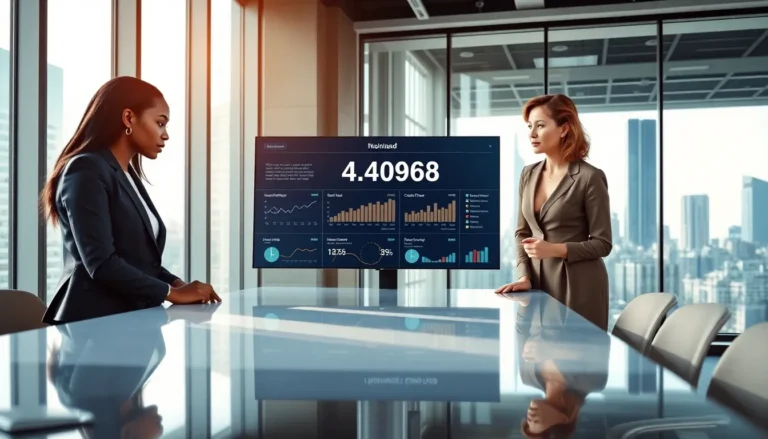Table of Contents
ToggleTechnology’s woven itself into the very fabric of society, and let’s be honest—it’s both a blessing and a bit of a curse. From smartphones that keep us connected to the latest cat memes to smart fridges that remind us we’re out of pickles, it’s hard to imagine life without these gadgets. But with every swipe and click, there’s a deeper story about how technology shapes our lives, influences our relationships, and even impacts our sanity.
Overview of Technology in Society
Technology significantly shapes the fabric of society. Everyday devices, such as smartphones and laptops, facilitate communication and information access. Social media platforms connect individuals across vast distances. They enhance relationships but often complicate them by fostering online distractions.
Educational systems increasingly rely on technology. E-learning tools provide flexible learning opportunities for students. Increased access to information empowers individuals but can lead to information overload. Privacy concerns arise from data collection practices, affecting trust in service providers.
Healthcare embraces technology in numerous ways. Telemedicine allows for remote consultations, improving access to care. Wearable devices monitor health metrics, promoting proactive health management. Despite advancements, ethical concerns about data security and patient confidentiality persist.
Economic impacts of technology are substantial. Automation in industries enhances efficiency but displaces jobs. The gig economy flourishes due to mobile applications, providing flexible job options. The divide between tech-savvy and less tech-proficient individuals widens, affecting economic opportunities.
Culturally, technology influences art and expression. Digital platforms enable artists to reach global audiences, transforming how art is consumed. Streaming services reshape the entertainment landscape, offering instant access to diverse content. Changes in consumption patterns challenge traditional media structures and advertising models.
Society faces challenges in navigating technology’s rapid evolution. Balancing benefits with potential harms remains essential. Discussions around digital literacy and responsible usage are critical for fostering a healthy relationship with technology. Understanding technology’s role in society promotes informed decision-making and encourages thoughtful integration into everyday life.
Impact of Technology on Daily Life

Technology permeates daily life in profound ways, influencing how individuals interact and learn.
Communication
Communication transformed dramatically through technology. Smartphones enable instant messaging, video calls, and social networking. These tools connect users globally, fostering relationships despite geographical barriers. While social media enhances communication, it also introduces distractions and misunderstandings. Eager users often prioritize virtual engagement over face-to-face interactions, altering social dynamics. Technology’s role in communication has created an environment where information spreads rapidly, yet accuracy sometimes suffers. These evolving communication norms underscore the importance of digital literacy, equipping users to navigate online interactions effectively.
Education
Education increasingly relies on technology as a key resource. E-learning platforms offer flexibility, accommodating diverse learning styles and schedules. Students access a wealth of knowledge through online courses and resources, expanding their educational horizons. While these innovations support learning, they can overwhelm users with information overload. Remote learning environments encourage self-discipline and accountability in students. Additionally, the digital divide highlights disparities, as those without access to technology may fall behind. Prioritizing equitable access remains crucial for maximizing technology’s benefits in education.
Economic Implications of Technology
Technology significantly impacts the economy, influencing job markets and transforming various industries. Its effects are evident in job creation, displacement, and the overall evolution of sectors.
Job Creation and Displacement
Automation impacts job availability, creating new roles while eliminating others. Some sectors gain positions, like IT and robotics, driven by advancements in automation. Conversely, jobs in manufacturing may decline as machines replace manual labor. According to a report from the World Economic Forum, 75 million jobs may be displaced by 2022, yet 133 million new roles could emerge due to technological advancements. Workers increasingly seek reskilling opportunities to remain competitive in this changing landscape. Transitioning to new job markets emphasizes the importance of adaptability and training to mitigate the negative effects of technological progress.
Industry Transformation
Industries rapidly evolve due to technological advancements. Manufacturing embraces automation through robotics, enhancing efficiency and productivity. Retailing experiences shifts with e-commerce platforms, reshaping consumer purchasing habits. In finance, digital banking and cryptocurrency innovate transaction methodologies, promoting faster processes. The healthcare sector also undergoes significant changes, utilizing technology for telehealth solutions and electronic health records. These transformations highlight how technology creates competitive advantages and drives growth across various sectors. Organizations adjusting to technological trends gain market leadership, showcasing the necessity for continuous innovation in a dynamic economy.
Social Issues Related to Technology
Technology influences various social issues, particularly privacy and the digital divide. These challenges necessitate thoughtful approaches to maximize benefits and mitigate risks.
Privacy Concerns
Privacy increasingly becomes a significant concern in the tech-driven world. Data breaches expose personal information, impacting trust in digital services. A report from Cybersecurity Ventures predicts that global cybercrime costs could reach $10.5 trillion annually by 2025. Individuals often underestimate the risks tied to their online activities. Companies collect vast amounts of personal data, sometimes without user consent. Transparency in data handling practices remains crucial. Improving legislation, such as the General Data Protection Regulation (GDPR), helps protect individual privacy. Awareness of privacy settings and permissions also empowers users to manage their information better.
Digital Divide
The digital divide reflects the gap between those with access to technology and those without. Approximately 3.7 billion people lack internet connectivity worldwide, limiting their ability to participate fully in society. Access differences can hinder educational and economic opportunities. Rural areas often experience less technological infrastructure compared to urban counterparts. The COVID-19 pandemic exacerbated this divide, as remote learning became essential. Addressing the digital divide involves improving infrastructure and providing affordable access to underserved communities. Initiatives, like the Federal Communications Commission’s (FCC) programs, aim to enhance internet accessibility. Prioritizing digital literacy education ensures individuals can navigate and utilize technology effectively.
The Future of Technology in Society
Emerging technologies will continue to reshape everyday life. Artificial intelligence, for instance, is poised to enhance decision-making across various sectors. In education, adaptive learning systems may personalize student experiences, ensuring better outcomes. While e-learning has gained traction, new forms of content delivery are essential to address information overload effectively.
The healthcare landscape is expanding with telemedicine and data analytics, ensuring broader access to quality care. Remote monitoring devices allow for continuous patient tracking, but ethical considerations related to data privacy must remain a priority. A recent report highlights that global cybercrime costs could rise to $10.5 trillion by 2025, making data security critical.
In the workplace, automation transforms industry operations. While many jobs face displacement, new positions often require advanced skills. A World Economic Forum study predicts 75 million roles may vanish, while 133 million new roles could emerge. Workers should actively pursue reskilling opportunities to adapt to this evolving environment.
Culturally, entertainment platforms will further evolve, providing artists a global stage. Streaming services allow diverse voices to flourish, even while reshaping traditional media consumption. Digital literacy has never been more essential for navigating this changing landscape, enabling informed choices.
Significant disparities in technology access remain a challenge. Approximately 3.7 billion people worldwide still lack internet connectivity, limiting opportunities for education and economic mobility. The COVID-19 pandemic highlighted these gaps, emphasizing infrastructure improvements and affordable internet solutions. Initiatives like the Federal Communications Commission’s programs address these challenges, promoting enhanced access along with digital literacy education.
Technology’s influence on society is undeniable and multifaceted. As it continues to evolve it brings both opportunities and challenges that require careful consideration. The balance between leveraging technology for improvement and managing its potential drawbacks is crucial.
Addressing issues like privacy concerns and the digital divide will be essential for fostering a more equitable society. Emphasizing digital literacy will empower individuals to navigate this complex landscape effectively.
Looking ahead the focus must remain on responsible integration of technology into daily life to ensure it serves as a tool for progress rather than a source of division.







